2 Biggest Reasons Content Marketing Fails
Let me begin this article by saying the two most important mistakes content marketers make:
-
- Actively or aggressively selling their services and products without priorly building a strong customer relationship.
- While some vendors or marketers are successful at creating rapport, they fail to use that good connection to actively sell their brand, products or services.
The Role of Content Marketing
Content marketing is at the heart of the Internet marketing ecosystem, but so many still fail at it. Before you differ and point out your content marketing achievements, let me clarify that I’m talking about using content to form a long-lasting bond with consumers, a bond that can generate more sales and long-lasting loyalty.
There’s this online marketing funnel devised by Marketing Experiments based on the three levels of customer relationship/commitment (relational, transactional and contractual). The funnel shows where content marketing fits in the entire web marketing system.
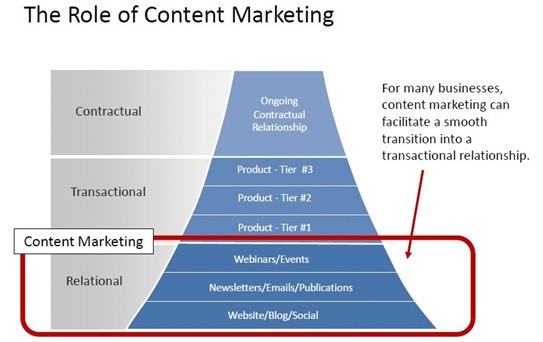
If you notice, content marketing embodies the bottom level of the funnel, the relational phase. This is the initial stage in web advertising, where you grab your target customers’ attention, build rapport, and create a heart connection that makes you audience eager to hear from you again.
Once you get a grip of that strong relationship, the next step is to turn the relational connection into a transactional one, which translates to using the relationship you’ve formed as a strategic advantage in selling your products and services. Vendors have a better chance at gaining leads or sales when they have a customer base that wholly trusts them.
The last tier of the funnel comprises the contractual phase. When the transactional level has evolved into something even more solid, your customers can be willing to enter a long-lasting commitment/relationship with you. Like signing a contract, this phase involves long-term partnerships.
Content marketing can take your business as far as you want to go. If you trace back the three levels of customer relationship, it all starts with content marketing.
So, the question now is: How? How does one build a strategy around content marketing to reap its full benefits? That is what the webinar sponsored by Marketing Experiments sought to teach. Hosted by Dr. Flint McGlaughlin and PR Newswire CEO Ninan Chacko, the webinar that introduced this magnificent funnel was called
5 Steps to Effective Content Marketing: How to Extract the Maximum Revenue for Your Content.
Flint McGlaughlin’s 5 Steps to Effective Content Marketing
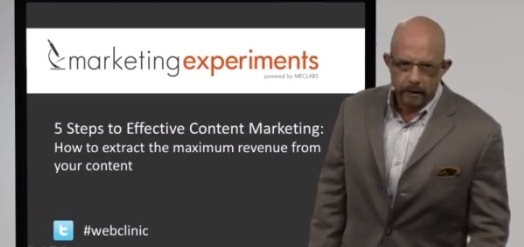
The case study
McGlaughlin opened the webinar with a case study that examined the cost-per-lead from using traditional direct response strategies and from applying content marketing to drive people to the doctors-only social network Sermo. The direct response approaches included standard lead generation forms that visitors have to fill out, while content marketing provided website visitors with useful medical information.
Findings from the case study revealed that by moving to new, innovative marketing tactics (content marketing) instead of traditional advertising (direct response), Sermo reduced cost-per-lead by 90%. That\’s an astonishingly stellar improvement.
In the case of the physicians\’ online community that is Sermo, it\’s easier to attract site visitors and readers with health information than bland sign up pages. After all, consulting Dr. Google is the first thing people do at the first sign of an unfamiliar illness. You\’re more successful at attracting a wide viewership when you offer content that serves customers because: one, on the Internet, people can choose what advertisements they receive, and two, interesting and useful content always wins.
McGlaughlin also likened content to a pickup line – you start hooking people’s attention with content. I have a different twist to this analogy: to maintain their interest in your business, you have to woo customers, take them out on a date, meet their parents, and say the right things. Then, your relationship becomes deeper and deeper over time until you have an inseparable bond (but of course, you don’t have to necessarily marry each of your customers).
Customer relationships aren\’t so different from love relationships.
Content Marketing the Most Efficient Way Possible – The 5 Steps
Now, let’s get to the juiciest part of the webinar.
Step 1: Map existing content across the funnel.
If you have existing content, re-evaluate them and see where they best fit in the funnel. The idea here is to “simplify and sequence” your content so that they are crystal clear to whoever chances upon your website.
The biggest challenge here is seeing your content through the eyes of your customers. Sometimes, our product listings, services and offerings are very clear to our eyes, but blurry to our prospects. Put yourself in your targets’ shoes so your content is more appealing.
Here are illustrations from the webinar:
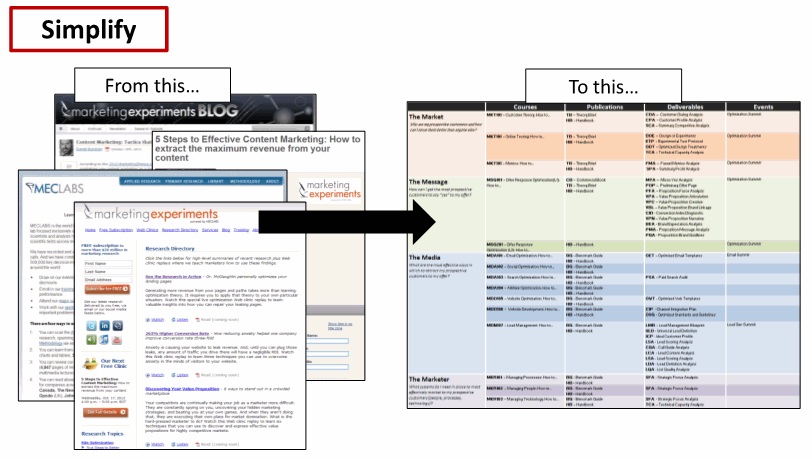
 Step 2: Produce a biological sketch of target customers.
Step 2: Produce a biological sketch of target customers.
Identify your target consumers. Who is your business selling to? Students? Business owners? Office workers? The stay-at-home mom? Once you’ve answered that, list down their traits, and go beyond consumer behaviors, just like how Marketing Experiments illustrated:

Lastly, connect your content to your target audience’s biographical sketch, like so:
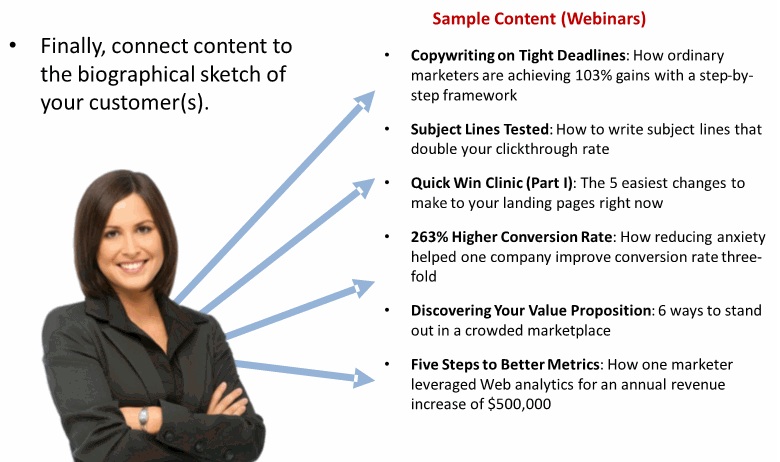 Step 3: Determine distribution channels that contain the most potential influence for you.
Step 3: Determine distribution channels that contain the most potential influence for you.
There are millions of online marketing platforms out there, such as LinkedIn, Facebook, forums, blogs and whatnot. Choosing the right channels is as important as the marketing platform itself. For instance, if your prospects aren’t the type who use LinkedIn, focusing on that channel can be a waste of your valuable time.
Here are three considerations for measuring a channel’s potential influence:
- Reach – What is your target number of people to influence?
- Intensity – To what extent of influence on a person do you want to reach?
- Capacity – How much change will each person we influence make?
Step 4: Ensure the connection between the relational content, and transactional and contractual decisions is clear.
At the end of the day, no matter how aggressive our marketing is, the results still boils down to the consumers’ choice. However, what we can do as marketers is influence their choice. This is where content marketing really comes into play. Powerful content can inspire prospects to choose your offerings over other businesses.
A concrete example of smooth transition between relational and transactional levels is featuring a download button within informative pages of your site. Of course, you should offer something valuable that visitors will be compelled to download, like an industry-related report.
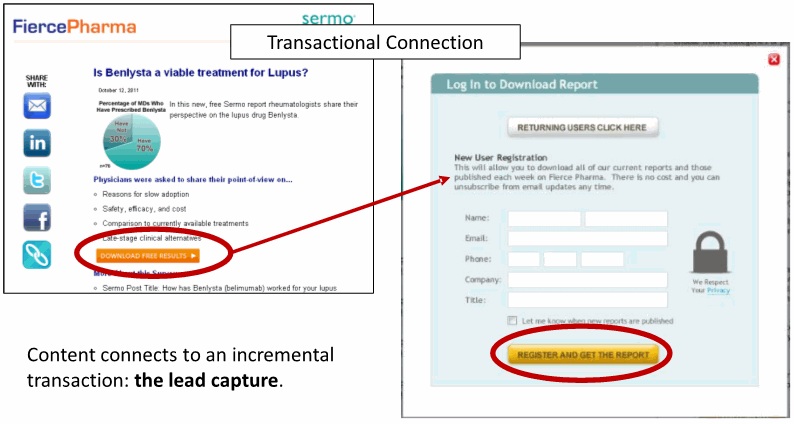
On a side note, it’s better to put the registration form behind your content because it shows you have valuable to offer. Remember, in-your-face ads will turn off potential customers.
Step 5: Refine the transactional message and the transition towards the contractual phase.
The key to moving customers towards a contractual relationship is showing that you
have more to offer and that you’re
consistent when it comes to value, information and quality. In you web pages, include links to more valuable reports and place them in strategic yet unobtrusive areas. Add a search box where site visitors can type in relevant topics found within your site.
When you keep the high-quality content coming, visitors will return. You\’ve established yourself as a reliable industry expert, so your perceived value rises.
All these findings and case studies were conducted in coordination with MECLABS, a research institution of which McGlaughlin is the founder. MECLABS specializes in putting market research to the test to get accurate and reliable results.
You can view the whole webinar here:
[youtube]http://www.youtube.com/watch?v=hVjwNMS9kvA[/youtube]
 If you notice, content marketing embodies the bottom level of the funnel, the relational phase. This is the initial stage in web advertising, where you grab your target customers’ attention, build rapport, and create a heart connection that makes you audience eager to hear from you again.
Once you get a grip of that strong relationship, the next step is to turn the relational connection into a transactional one, which translates to using the relationship you’ve formed as a strategic advantage in selling your products and services. Vendors have a better chance at gaining leads or sales when they have a customer base that wholly trusts them.
The last tier of the funnel comprises the contractual phase. When the transactional level has evolved into something even more solid, your customers can be willing to enter a long-lasting commitment/relationship with you. Like signing a contract, this phase involves long-term partnerships.
Content marketing can take your business as far as you want to go. If you trace back the three levels of customer relationship, it all starts with content marketing.
So, the question now is: How? How does one build a strategy around content marketing to reap its full benefits? That is what the webinar sponsored by Marketing Experiments sought to teach. Hosted by Dr. Flint McGlaughlin and PR Newswire CEO Ninan Chacko, the webinar that introduced this magnificent funnel was called 5 Steps to Effective Content Marketing: How to Extract the Maximum Revenue for Your Content.
If you notice, content marketing embodies the bottom level of the funnel, the relational phase. This is the initial stage in web advertising, where you grab your target customers’ attention, build rapport, and create a heart connection that makes you audience eager to hear from you again.
Once you get a grip of that strong relationship, the next step is to turn the relational connection into a transactional one, which translates to using the relationship you’ve formed as a strategic advantage in selling your products and services. Vendors have a better chance at gaining leads or sales when they have a customer base that wholly trusts them.
The last tier of the funnel comprises the contractual phase. When the transactional level has evolved into something even more solid, your customers can be willing to enter a long-lasting commitment/relationship with you. Like signing a contract, this phase involves long-term partnerships.
Content marketing can take your business as far as you want to go. If you trace back the three levels of customer relationship, it all starts with content marketing.
So, the question now is: How? How does one build a strategy around content marketing to reap its full benefits? That is what the webinar sponsored by Marketing Experiments sought to teach. Hosted by Dr. Flint McGlaughlin and PR Newswire CEO Ninan Chacko, the webinar that introduced this magnificent funnel was called 5 Steps to Effective Content Marketing: How to Extract the Maximum Revenue for Your Content.


 Step 2: Produce a biological sketch of target customers.
Identify your target consumers. Who is your business selling to? Students? Business owners? Office workers? The stay-at-home mom? Once you’ve answered that, list down their traits, and go beyond consumer behaviors, just like how Marketing Experiments illustrated:
Step 2: Produce a biological sketch of target customers.
Identify your target consumers. Who is your business selling to? Students? Business owners? Office workers? The stay-at-home mom? Once you’ve answered that, list down their traits, and go beyond consumer behaviors, just like how Marketing Experiments illustrated:
 Lastly, connect your content to your target audience’s biographical sketch, like so:
Lastly, connect your content to your target audience’s biographical sketch, like so:
 Step 3: Determine distribution channels that contain the most potential influence for you.
There are millions of online marketing platforms out there, such as LinkedIn, Facebook, forums, blogs and whatnot. Choosing the right channels is as important as the marketing platform itself. For instance, if your prospects aren’t the type who use LinkedIn, focusing on that channel can be a waste of your valuable time.
Here are three considerations for measuring a channel’s potential influence:
Step 3: Determine distribution channels that contain the most potential influence for you.
There are millions of online marketing platforms out there, such as LinkedIn, Facebook, forums, blogs and whatnot. Choosing the right channels is as important as the marketing platform itself. For instance, if your prospects aren’t the type who use LinkedIn, focusing on that channel can be a waste of your valuable time.
Here are three considerations for measuring a channel’s potential influence:
 On a side note, it’s better to put the registration form behind your content because it shows you have valuable to offer. Remember, in-your-face ads will turn off potential customers.
Step 5: Refine the transactional message and the transition towards the contractual phase.
The key to moving customers towards a contractual relationship is showing that you have more to offer and that you’re consistent when it comes to value, information and quality. In you web pages, include links to more valuable reports and place them in strategic yet unobtrusive areas. Add a search box where site visitors can type in relevant topics found within your site.
When you keep the high-quality content coming, visitors will return. You\’ve established yourself as a reliable industry expert, so your perceived value rises.
All these findings and case studies were conducted in coordination with MECLABS, a research institution of which McGlaughlin is the founder. MECLABS specializes in putting market research to the test to get accurate and reliable results.
You can view the whole webinar here:
[youtube]http://www.youtube.com/watch?v=hVjwNMS9kvA[/youtube]
On a side note, it’s better to put the registration form behind your content because it shows you have valuable to offer. Remember, in-your-face ads will turn off potential customers.
Step 5: Refine the transactional message and the transition towards the contractual phase.
The key to moving customers towards a contractual relationship is showing that you have more to offer and that you’re consistent when it comes to value, information and quality. In you web pages, include links to more valuable reports and place them in strategic yet unobtrusive areas. Add a search box where site visitors can type in relevant topics found within your site.
When you keep the high-quality content coming, visitors will return. You\’ve established yourself as a reliable industry expert, so your perceived value rises.
All these findings and case studies were conducted in coordination with MECLABS, a research institution of which McGlaughlin is the founder. MECLABS specializes in putting market research to the test to get accurate and reliable results.
You can view the whole webinar here:
[youtube]http://www.youtube.com/watch?v=hVjwNMS9kvA[/youtube] 